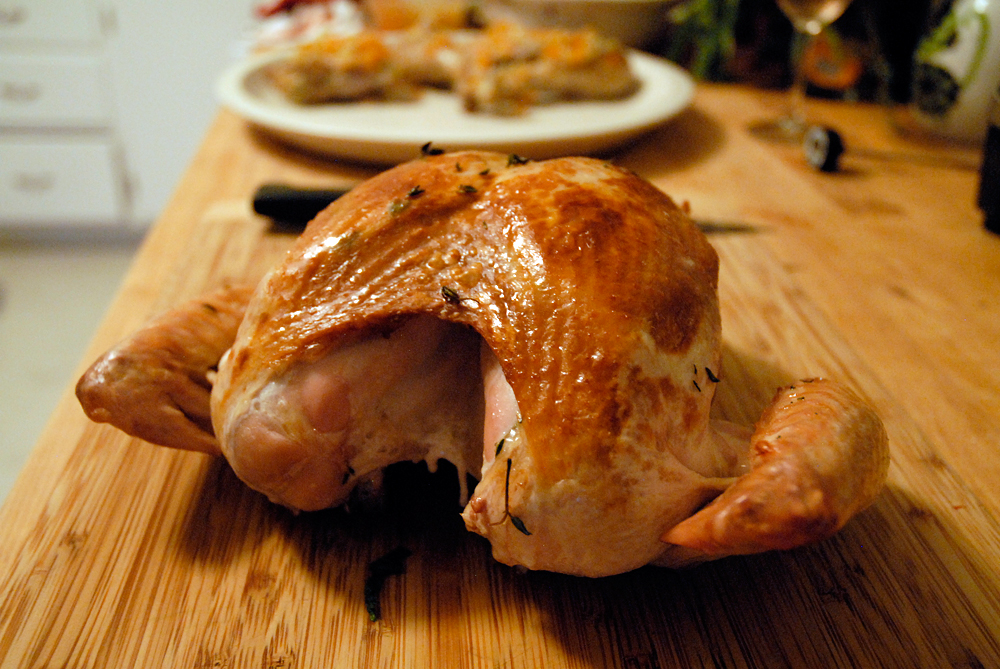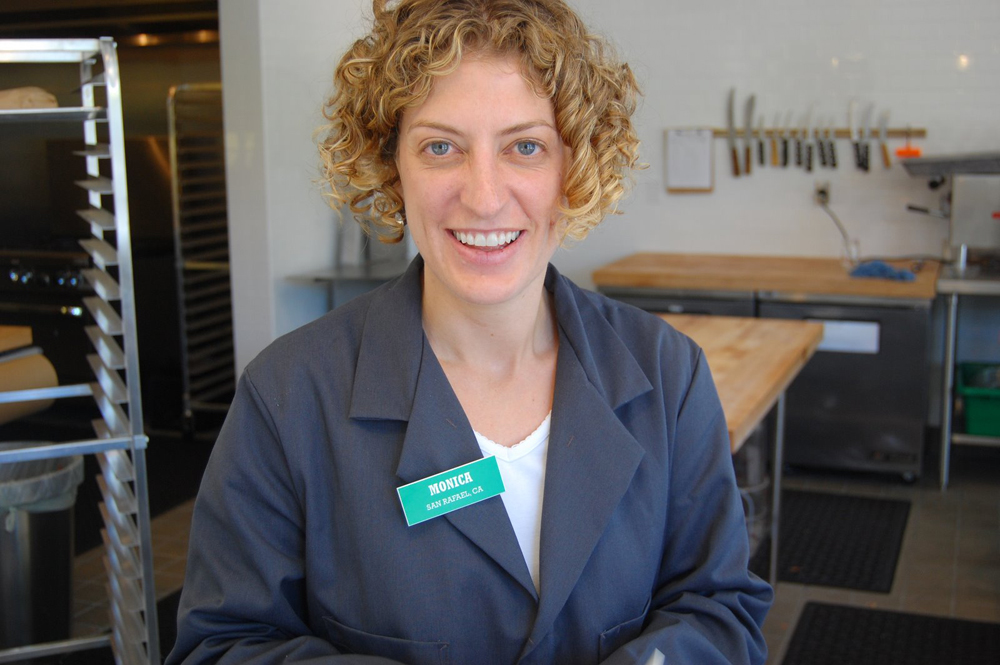Rocchino: There are two big mistakes. Number one, you have to bring the bird up to room temperature before you put it in the oven. This allows for even cooking rather than the outside getting hammered with heat while the inside tries to catch up. Number two, you have to let the turkey rest before you carve it. This can take up to an hour. If you don’t allow the turkey to rest, all of the juices will spill out when you carve it, leaving a really juicy cutting board and a really dry turkey. It’s better to have a room temperature piece of turkey that is juicy with hot gravy on top rather than a piping hot slice of turkey that is super dry.
Bay Area Bites: How do you know when your turkey is ready?
Rocchino: Any instant read thermometer will do the trick. Make sure it is calibrated before you use it. When you take the bird’s temperature, make sure to test it in the thickest part of the thigh, which takes the longest to cook. Again, it’s best to cook the turkey in parts so that your breast is cooked correctly and your legs are also cooked correctly.
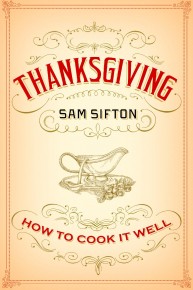
Still need a little hand-holding to get you through the run-up to the big day? What you need is a book that will make you feel like you're hanging out in the cozy kitchen of the writer as he or she stirs, fries, gossips, and bakes. On this front, nothing beats Sifton's Thanksgiving: How to Cook it Well. Sifton spent close to a decade as a writer and editor at the New York Press, a scrappy alternative weekly, before he was tapped for the dining section of the New York Times. So, despite two years as the Times' restaurant critic--an Olympian position if there ever was one--Sifton's voice is amusing and approachable, pretense-free but reassuringly knowledgable. For a couple of years he spent Thanksgiving Day in the newsroom of the Times, answering panicked questions from readers. As he writes,
"I was a one-man Thanksgiving help line. The questions came fast and furious...I answered questions on the newspaper's Web site about burning turkeys and still-frozen ones, bland gravies and last-minute cranberry sauces, too-thick corn puddings, underdone squash, what to do with someone's vegan aunt or carnivorous boss. I consulted on failed pumpkin pies and epic turducken blunders. I worked the turkey-oven-temperature-time equation as if studying for a doctoral exam."
He stands up for cloth napkins, nothing canned (except for canned pumpkin for pies, and, if you must, that wiggly cranberry jelly), and proper table settings and passed family-style platters rather than piles of plates next to serve-yourself pans on the kitchen counter. But he doesn't care if your table is plywood and your plates mismatched; it's the gesture, not the price of the wedding china, that counts. The main thing is finding joy in your companions and serenity, somewhere, in the cooking.
Even if you have your recipes nailed down, his book is worth a read for its numerous helpful hints. Sketch out the pots and pans you'll need to cook each dish ahead of time, so you know what might be missing before you're elbow-deep in squash. Ditto laying out all the serving dishes and utensils on the dinner table a day or two beforehand. That way, you'll know, first, if they fit, and second, if you need to shop for (or borrow) an extra gravy boat, more serving spoons, or a bigger bowl for the mashed potatoes. (Plus, festive anticipation!)
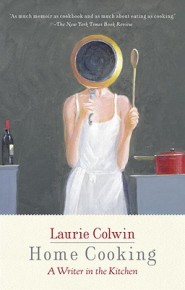 Innumerable Thanksgivings across the land have been bettered by the Cornbread and Proscuitto Stuffing recipe detailed in "Stuffing: A Confession" in Laurie Colwin's Home Cooking, and by the roast turkey, turkey jook, turkey salad, pecan-chestnut stuffing, and Cider Jelly in "Turkey Angst" and "All the Trimmings" from More Home Cooking.
Innumerable Thanksgivings across the land have been bettered by the Cornbread and Proscuitto Stuffing recipe detailed in "Stuffing: A Confession" in Laurie Colwin's Home Cooking, and by the roast turkey, turkey jook, turkey salad, pecan-chestnut stuffing, and Cider Jelly in "Turkey Angst" and "All the Trimmings" from More Home Cooking.
Colwin, a much-loved novelist who died in 1992, has an unmistakable voice: funny, chatty, warm, encouraging and confident that anyone who wants to can turn out a decent meal. Speaking from happy experience, I can attest that just about all her recipes can be made in a tiny kitchen, using garage-sale equipment, with a much greater payoff in pleasure than their humble ingredients might warrant at first glance.
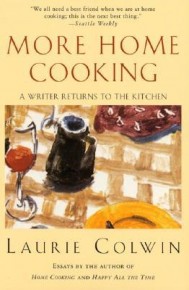 My copies of her two books of essays-with-recipes are annotated, soup-splashed, and falling apart with love and use. When I go into new friends' homes and see their own battered versions, I know we'll be not only good friends but like-minded partners in the kitchen. As Colwin writes about her leftover turkey salad, studded with scallions and capers and dressed with lemon-spiked mayonnaise,
My copies of her two books of essays-with-recipes are annotated, soup-splashed, and falling apart with love and use. When I go into new friends' homes and see their own battered versions, I know we'll be not only good friends but like-minded partners in the kitchen. As Colwin writes about her leftover turkey salad, studded with scallions and capers and dressed with lemon-spiked mayonnaise,
"You need not feel greedy if this turkey salad is consumed entirely by you. A person who bastes a turkey all day long on behalf of other people's holiday pleasure deserves it. This person is a saint, and if she or he has finished off all the nicest turkey bits plus the last of the capers, tough darts. Turkey roasting's heroes deserve rewards."
Colwin's approach, sensible and unfussy, is a less profane version than cooking teacher Mary Risley's now-classic moment of Thanksgiving reassurance, Just Put the F*cking Turkey in the Oven.
But if the thought of cooking that toddler-size carcass in the fridge is keeping you up at night, Culinary Birds: The Ultimate Poultry Cookbook will calm you down more effectively than chug-a-lugging the Pinot on Thursday morning. Longtime wine country chef, culinary instructor and cookbook author John Ash breaks down all the basics you need to know to get your bird on the table browned, juicy, and ready for carving. He offers two main Thanksgiving-classic recipes: Roast Turkey with herb gravy, and Smoked Turkey on the Grill (recipe below), both brined in a salt solution flavored with maple syrup, fresh ginger, soy sauce, and garlic.
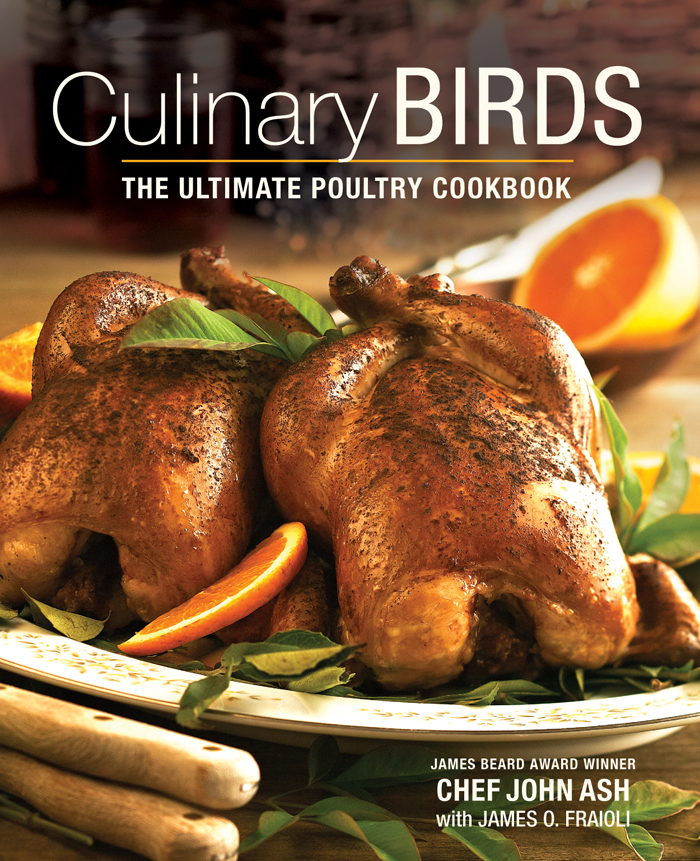
Recipe: Smoked Turkey on the Grill
Reprinted with permission from Culinary Birds by John Ash, Running Press 2013.
You’ll need a barbecue with a tight cover so that you can control the amount of oxygen and heat. To maximize the flavor and moisture, brine the bird first, then select a good hardwood to use as the smoking medium. You can find them in various sizes from sawdust to small chips to chunks. They all work. Hickory and oak are probably the most commonly available, but also look for fruit woods such as apple, pear, cherry, walnut, or pecan. You will need a good thermometer. I prefer the digital version, which you can leave in the bird the entire time. Use the indirect method described in the recipe and be sure to regulate the heat so that the bird doesn’t cook too quickly.
The following recipe makes a gallon or so of brine, which should be plenty for a 12- to 14-pound turkey.
MAKES 12 SERVINGS
2 cups (400g) packed brown sugar
1 cup (250g) pure maple syrup
3/4 cup (170g) coarse salt
3 whole heads garlic, cloves separated and bruised
6 large bay leaves
1 1/2 cups (144g) coarsely chopped unpeeled fresh ginger
2 teaspoons dried red chili flakes
1 1/2 cups (350mL) soy sauce
3 quarts (2.85L) water
12- to 14-pound (5.4 to 6.3kg) dressed fresh turkey
1. Combine all the ingredients except the turkey in a large enamel or stainless steel stockpot that is large enough to hold the brine and the turkey. Bring to a simmer and then remove from the heat and allow to cool thoroughly. Rinse the turkey well; remove the neck and giblets, and save them for stock or discard.
2. Submerge the turkey in the cooled brine. Be sure there is enough brine to cover the bird. If not, add water to cover. Refrigerate for at least 2 days and up to 4. Turn the bird in the brine twice a day.
3. Remove the bird from the brine and pat dry. Lightly brush the bird with olive oil and set aside. Prepare the barbecue by lighting 24 charcoal briquettes (preferably in a chimney starter). When hot and spotted gray, divide the briquettes in half and push to opposite sides of the grate. Place a metal drip pan that is at least 1 inch deep in the center with the hot coals on either side. The pan should be large enough to catch the drips from anywhere on the turkey.
4. Place a half cup or so of the wood smoking chips in the center of a double layer of heavy duty foil cut approximately 10 inches square. Form the foil into a ball shape and poke some holes in it. Place on top of one of the mounds of hot coals*.
5. Put the upper rack of the barbecue in place and then center the turkey on the rack over the drip pan. Cover the barbecue and partially close the air vents to restrict the oxygen (but not so much so that you put out the coals). Within a few minutes, the wood chips should start smoking. Regulate the vents to keep the chips smoking and the coals slowly burning. Check every 25 minutes or so to make sure the coals are still hot and smoke is continuing. Add charcoal and additional chips as needed. The internal temperature of the barbecue should be in the 275°F to 300°F range.
6. Keep the smoke going for 1 1/2 to 2 hours. After that, remove any remaining wood chips and continue cooking without smoke until the bird is done. This ensures that the turkey will not be too smoky in flavor, but you can adjust to taste. The total cooking time for a 12- to 14-pound bird will be approximately 3 to 3 1/2 hours. The internal temperature of the bird should be 165°F when tested at the thickest part of the thigh or breast. Make sure the thermometer is not touching bone. You can also test by cutting a little incision at the leg-thigh joint and making sure the meat is cooked and juices run clear.
7. Remove the turkey from the barbecue and allow it to rest at least 30 minutes before carving.
